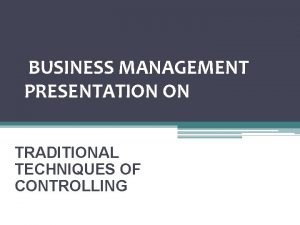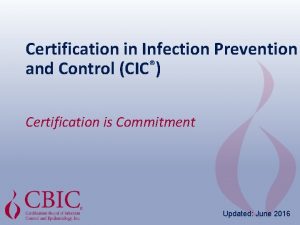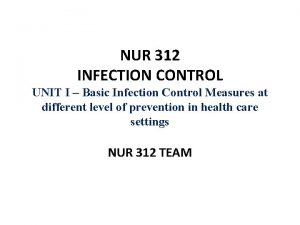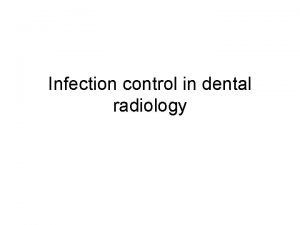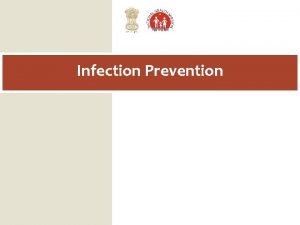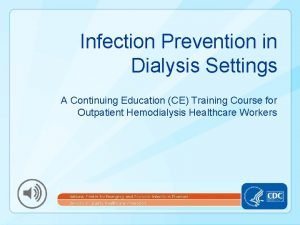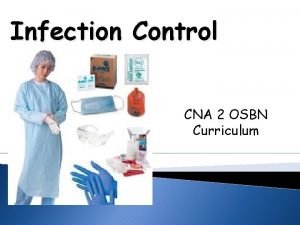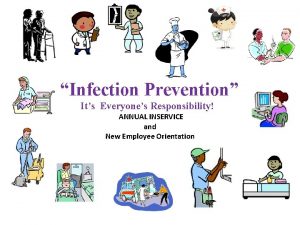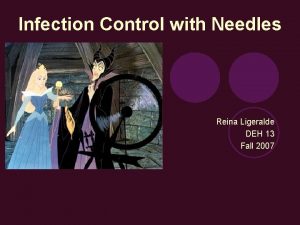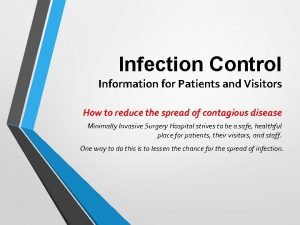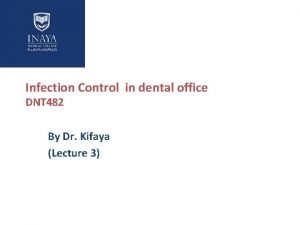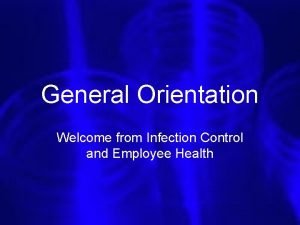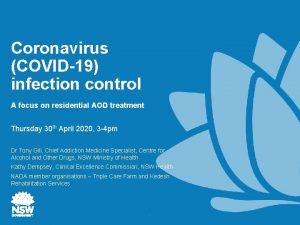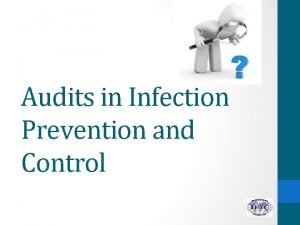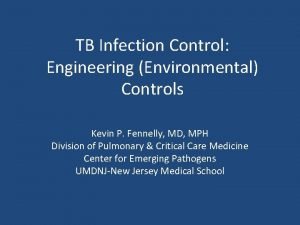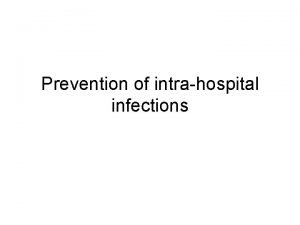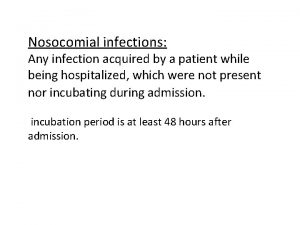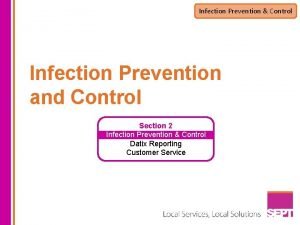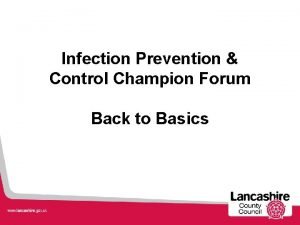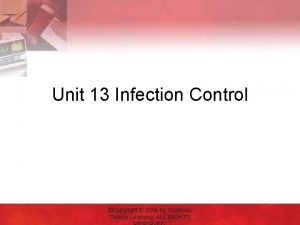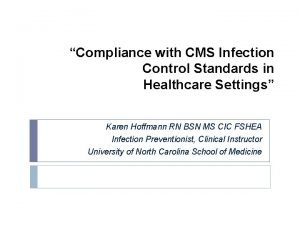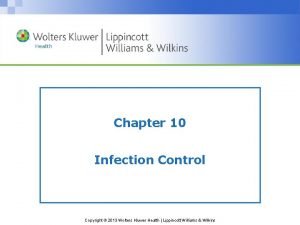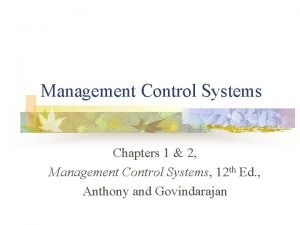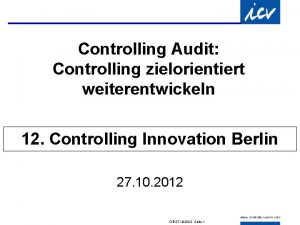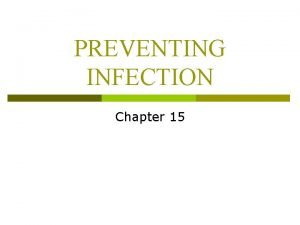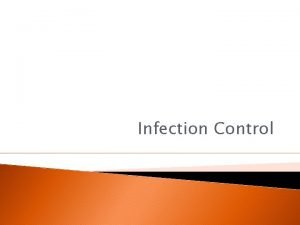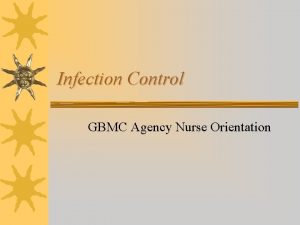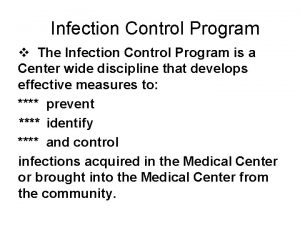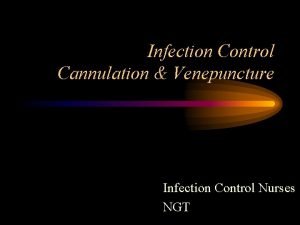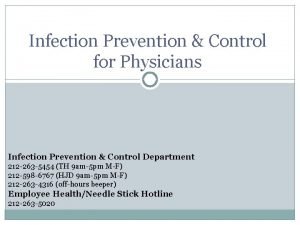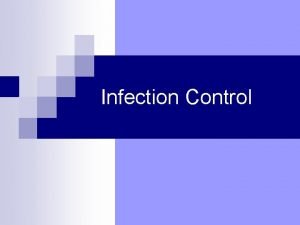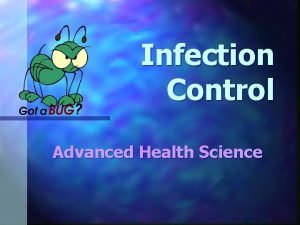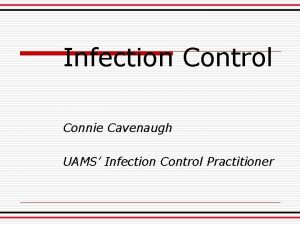Infection Control Goal To learn techniques for controlling
































































- Slides: 64

Infection Control Goal To learn techniques for controlling infection during patient care and accept responsibility for infection control during radiography.

Objectives After completing this chapter you will be able to: n Define the relevant terminology n List and describe four types of microorganisms n List and define three elements needed to produce an infection n List and explain four means of transmitting microorganisms n Describe 12 methods that can be used routinely to control infection in practice of Radiography n Demonstrate the correct method of hand-washing for medical asepsis n Define the seven category-specific methods of isolation n Demonstrate the correct method of entering and leaving an isolation room by means of strict isolation technique.

Introduction Infection control in health care institutions is essential to the safety of n n n Patients Their families, and Healthcare workers. All health workers are taught the concepts and procedures of infection control Patients are also responsible for complying with infection control measures while in the hospital. Their visitors must also comply.

Introduction continued n n People come to the radiology department from many different environments they will bring disease with them. Though some patients arrive in apparent good health, all must be regarded as potential carriers of disease. Every piece of equipment must be thoroughly cleaned after each use RT must use every means available to protect his patient, his coworkers and himself from infection.

NOSOCOMIAL INFECTIONS n n The infections acquired by patient while in hospital The frequent types of nosocomial infections are, n n Urinary tract infections associated with the use of indwelling catheters. Wound infections following surgical procedures Respiratory tract infections § § Strict precautions should be taken to prevent this type of infections

MICROORGAMISMS Four major groups of microorganisms n Bacteria n Fungi n Viruses n Protozoas Within these four groups there are many species i. Some of them may produce infections in man ii. Some are useful and/or not harmful.

n n Some microorganisms that are natural flora in one area of the body produce infection are in an other area. E. g. , Escherichia coli, normally inhabits the human intestinal tract, can cause urinary tract infection if it enters to the urinary bladder. Unharmful Microorganisms are, n n used in food and drug processing destroy waste

Bacteria n n Minute, one-celled organisms without a typical nucleus. Contain both DNA (deoxyribonucleic acid) and RNA (ribonucleic acid). n n Bacteria are classified according to their shape. § § § Cocci – (spherical) Bacilli – (oblong) Spirilla – (spiral) They may be classified according to their divisional grouping. n n DNA carries the inherited characteristics of a cell. RNA constructs cell protein in response to the direction of DNA Diplococci – (groups of two) Streptococci – ( chains) Staphylococci – (grapelike bunches) They may also be classified by their reaction to various staining processes in laboratory. n n n Gram-positive – (bacteria take the stain) Gram-negative – (bacteria do not take the stain) Acid-fast - ( bacteria are resistant to decolorization by alcohol).

Forms of Bacteria – Cocci & Bacilli Staphylococcus epidermidis STEPTOCOCCUS MUTANTS Micrococcus lutes Bacillus cereus Flagellated bacilli

Forms of Bacteria A cell of Vibro cholerae Variety of organisms in dental plaque Spore of Bacillus fastidiosus The spirillum

n n n Some types of bacteria form spores. A spore is a protective coat that surrounds the nucleic material of a bacteria. They protect the bacteria when it is in an unfavourable atmosphere for growth and reproduction. Spores are difficult to de story than the vegetating bacteria. Bacteria are often opportunists. They are able to adapt to any situation and carry on their lives. They may also learn to resist or thrive in the presence of antimicrobial drugs and disinfectants.

Some common diseases produced by bacteria § n n n Diptheria Tuberculosis Streptococcal infections of the throat Boils Abscesses Wound infections Salmonella infections

FUNGI n Fungi exist in two forms. n n n n Yeasts Molds Yeasts are one-celled animals. Molds have many cells. Some fungi have the characteristics of both yeasts an molds. Fungi reproduce by budding or spore formation. 50% of fungi may cause disease in humans, but they require moisture and darkness in order to do so. Many pathogenic fungi infect the skin and scalp of humans and are difficult to cure because they produce spores. Fungal infections affect body systems and are difficult to treat because most anti microbial drugs are not effective against fungi.

Viruses n n Viruses are minute microorganisms that cannot be visualized under an ordinary microscope. Their genetic material is composed of either DNA or RNA but never both. This genetic material is protected by a capsid or outer coat until they invade a host cell. They must invade a host cell in order to survive and reproduce. The capsid acts as a vehicle of transport. When the virus selects a host, it attaches itself to the cell on the surface and penetrates the cell. Once inside, the capsid disintegrates and releases its nucleic acid into the host cell. The virus then replicates, and the newly produced nucleic acid and proteins assemble into new virus and leave the host cell. As they leave, they sometimes destroy the host cell by rapid release of the new viruses.

Viral diseases n n Viruses may infect plants, animals, or humans. Some viral diseases that affect humans are; n n n n n Influenza Measles Mumps Hepatitis A, B Non-A non –B hepatitis Herpes zoster Herpes simplex Acquired immunodeficiency syndrome (AIDS) Common cold

Protozoa n n n Protozoa are more complex one-celled microorganisms than others. They are often parasitic Move from place to place n n n n by pseudopod formation by the action of flagella, by cilia. Pseudopod movement is an amoeboid action ( a part of the cell is pressed forward and the rest of the cell rapidly follows). Flagella are whip like projections, which move the cell by their swift movements. Cilia are smaller an more delicate hairlike projections on the exterior of the cell wall Many protozoa are able to form themselves into cysts, which are protected by a cyst wall in averse conditions to prolong their existence.

n Many of the diseases in human caused by protozoa affect ; n n n n n the gastrointestinal tract the genitourinary tract, and the circulatory system. Some common protozoal diseases are; Amebiasis Giardiasis Trichomoniasis Malaria Toxoplasmosis

The body’s defense against disease (Immunity) n Two types : n n 1. Active immunity Passive immunity Active immunity Born immunity to some diseases (specific & nonspecific) Acquired immunity by actually having the disease and producing antibodies that prevent another infection or by being vaccinated with dead or weakened strains of the infecting microorganism (attenuated vaccine) or their products.

Active immunity continued… specific defense mechanism n The human body has a highly complex immune system that, react to specific invaders that are able to bypass the nonspecific body defenses by forming an antigen (a foreign protein). n When an antigen is present in the body, a specific antibody is formed to act against it. n An antibody is a protein globulin produced by specific cells in the immune system when stimulate by an antigen. n Antibodies form to react against an invading antigen to produce an immunity to further infection by that particular antigen.

Active immunity continued… The nonspecific defense system n The skin, the hair, ciliate mucous membranes in the upper respiratory tract, and the acidic condition of the mucoid linings of body organs all react to any foreign substance or microbe to prevent infection from beginning. n The composition and flowing action of urine prevents urinary tract infections. n Lysosome in human tears protects the eyes against infection. n In the bloodstream, white blood cells called macrophages and neutrophils try to destroy foreign antigens. n In the tissues, wandering tissue macrophages rush to an area of contamination and indiscriminately destroy the invading molecules.

2. Passive immunity n n n Passive immunity may be acquired by injection of antibodies of a particular infection into an individual. Also, antibodies may be passed from mother to fetus in the uterus to protect the infant until his own immune system is mature enough to function. Passive immunity is a short term immunity, because as the injected or transmitted antibodies are broken down, they are not replaced.

Autoimmune Diseases n n The diseases produced occasionally by antibodies functioning as antigens are called autoimmune diseases. This occurs when substances identical to one’s own tissues stimulate antibody production and these substance react with the host’s tissues in an adverse manner. In other words one’s own antibodies destroy healthy tissue.

Interferon & Biologic response modifiers n n n Interferon an is agent released by body cells in response to viral invasion to impede the multiplication of viruses in the body. It, along with other immune responses, is instrumental in inhibiting multiplication of viruses. Interferon is identified as one of a group of agents discovered in the last century to be produced by the body which increases, directs , and restores the body’s immune system following attack by foreign agents. As a group these newly discovered substances are called biologic response modifiers. They also react against tumour cells present in the body to restrict their growth. Biologic response modifiers are now being produced in laboratories and tested in cancer treatment.

THE PROCESS OF INFECTION When a pathogenic microorganism enters the body the infection takes place. Infection invades the body by breaking the body’s defense mechanism in a progressive manner. There are for phases or stages. n n n Incubation period Prodromal phase Active phase Convalescence phase

THE PROCESS OF INFECTION n Incubation period This is the period that begins when a pathogenic microorganism enters the body and ends when the actual symptoms of the disease begin. The disease is not detectable during this period. But it may be contagious /communicable during this period.

THE PROCESS OF INFECTION n Prodromal phase During this period early signs and symptoms of the disease are demonstrated.

THE PROCESS OF INFECTION n Active phase During this time all of the characteristic signs an symptoms of the disease are at their peak.

THE PROCESS OF INFECTION n Convalescence phase During this time the symptoms begin to diminish and eventually disappear or, as in the case of some chronic infections go into a phase of remission. Many infectious diseases are not communicable in this phase.

Elements needed to produce infection n To begin an infection there should be three elements. n A source n A host n A means of transmission

Elements needed to produce infection Source n A source is a person with or incubating disease. n (This may be a patient, a health worker, or a visitor. The RT should not work when he is ill or when he knows that he could be incubating a contagious disease)

Elements needed to produce infection Host n A host is any susceptible person. Particularly susceptible persons are those who are fatigued or poorly nourished. People with chronic illnesses such as diabetes mellitus, cancer, and uremia are at a great risk.

Elements needed to produce infection Means of transmission 1. By Direct contact - touching of a person or and animal, his blood, or body fluids 2. By Indirect contact – touching objects contaminated by an infected person 3. By Droplet – contact with infectious secretions from the conjunctiva, nose, or mouth of a disease carrier when he coughs, sneezes or talks. (droplets can travel 3 -5 feet) 4. By Vehicle – by food, water, drugs, or blood 5. By Vector – stinging by insects or biting by animals 6. By air bone route – inhaling of residue from evaporated droplets of diseased person

Techniques of Infection Control § Controlling infection means the breaking of the cycle of § n n infectivity. The transmission of microorganisms from the source to the host is to be avoided. It is the duty of all health workers. In radiographic procedures it is achieved by following medical aseptic rules. Medical aseptic practice should become routine for radiographers. It is not practical or necessary to practice surgical asepsis at all times, but one must always adhere to the practice of strict medical asepsis.

Techniques of Infection Control n n Medical asepsis means that as far as possible, microorganisms have been eliminated through the use of soap, water friction, and various chemical disinfectants. Surgical asepsis means that microorganisms and their spores have been completely destroyed by means of heat or by a chemical process.

12 methods of infection control in routine practice of Radiography 1. Dress appropriately in the work place 2. Dress your Hair in such a way to avoid contamination 3. Wash your hands properly before and after patient care 4. Wear disposable gloves when appropriate 5. Wear eye glasses to Protect your eyes when appropriate

12 methods of infection control in routine practice of Radiography 6. Use Proper Cleaning and proper waste Disposal techniques 7. Disinfect properly the items used for patients 8. Disinfect the radiographic table and accessories properly 9. Be aware of Isolation precautions (Protective asepsis) 10. Use correct guidelines when entering, while inside and when leaving an strict isolation room

12 methods of infection control in routine practice of Radiography 11. Use correct guidelines when transferring isolated patients 12. Use strict precautions when dealing with contagious patients in the x-ray department

1. Dress appropriately in the work place n n n n The RT should dress appropriately to avoid the transmission of microorganisms. Don’t wear jewelry, such as rings with stones. Cracked or chipped nail polish should not be used. Wear freshly laundered washable clothing. Uniforms are recommended because they will not be worn for other purposes. Short sleeves are recommended, because cuffs of uniforms are easily contaminated. If a laboratory coat is worn to protect clothing, it should be buttoned or zipped closed an remove when one is not in the work area. Laboratory coats and uniforms must be washed daily with hot water and detergent. A protective gown should be worn when working with any patient who may soil your clothing or if blood or body fluids may contaminate clothing.

2. Dress your Hair in such a way to avoid contamination n Hair follicles and filaments also harbor microorganisms. Hair is also a major source of staphylococcus contamination. Therefore, hair must be worn short or in a style that keeps it up and away from your clothing and the patient.

3. Wash your hands properly before an after patient care n n n Hand- washing Microbes are most commonly spread from one person to another by hands. Therefore the best means of preventing the spread of microorganisms is hand-washing. Correct hand-washing procedure is required before and after, n n Handling supplies used for patient care. Each patient contact even if gloves are used for the procedure.

Correct hand-washing technique for medical asepsis 1. 2. 3. 4. 5. 6. 7. 8. 9. 10. 11. 12. 13. 14. 15. 16. Approach the sink. Do not allow your uniform to touch the sink because the sink is considered contaminated. Turn the tap. If the faucet is turned on by hand, use a paper towel to touch the handle. Regulate the water to a comfortably warm temperature. regulate the flow of water so that it does not splash from the sink Keep your hands and forearms lower than the elbows. Wet the hands and soap them well. When using bar soap, rinse it before using and hold it during entire procedure. With a firm circular rubbing motion, wash the palms, the backs of the hands, each finger, between fingers, an finally the knuckles. Rinse the hands well under running water. Wet the wrists and forearms to the elbows. Apply soap and rub as before. Rinse, allowing the water to run down over the hands. (clean the finger nails with a brush or an orange stick once each day before beginning work , and again if the hands become heavily contaminated. ) (repeat the procedure if necessary) Rinse the soap well and replace it in the dish. (Do not touch the sink or the soap dish) Rinse the fingers well under the running water. Turn off the water (use a paper towel) Dry the arms and hands using as many towels as necessary.

4. Wear disposable gloves when appropriate n n n n n Wearing and removing Gloves Disposable, single-use gloves are to be warn any time when the radiographer is likely to patient’s blood or body fluids. They are worn simply by pulling them on after hand-washing. The gloves should be removed using the following technique to prevent contamination. With the gloved right hand, take hold of the upper, outside portion of the left glove and pull it off, turning inside out. Hold the glove that you have just removed in the palm of the remaining gloved hand. With the clean, bare index an middle fingers reach inside the top of the soiled glove and pull it off, turning it inside out an folding the first glove inside it. Drop the soiled gloves into a contaminated waste receptacle Wash your hands.

5. Wear eye glasses to Protect your eyes when appropriate n n Eye protection There is evidence that eyes may be a port of entry for pathogenic microorganisms. Therefore in situations where there is a risk of spattering of blood or body fluids, the radiographer must wear goggles or eye glasses to avoid contamination. Hands must be kept away from eyes during the course of work.

6. Use Proper Cleaning and proper waste Disposal techniques n 1. 2. 3. 4. 5. 6. Guide lines for waste disposal and cleaning of equipment after each patient Wear a fresh (cleaned) uniform each day. Keep the uniforms away from other cloths. Shoes should be cleaned and stockings should be fresh each day Pillow coverings should be changed after each use by a patient. Linens use for adorns or blankets for patients should be handled in such a way that they do not raise dust. Dispose of linens after each use by patient. Flush away the contents of bedpans or urinals promptly unless they are being saved for a diagnostic specimen. Rinse bedpans and urinals and send them to the proper place for re-sterilization if they are not to be reused by the same patient. Use equipment an supplies for one patient only. After the patient leaves the area, supplies must be destroyed or sterilized before being used again. Keep water and supplies clean and fresh. It is best to use paper cups and dispose of them after a single use.

Guide lines for waste disposal and cleaning of equipment 7. 8. 9. 10. 11. Floors are heavily contaminated. If an item that is use for patient care falls to the floor, discard it or send it to the proper department to be re-cleaned. Avoid raising dust because it carries microorganisms. When cleaning , use a cloth thoroughly moistened with a disinfectant. The radiographic table should be cleaned with a disposable disinfectant towerlette or sprayed with disinfectant and wipe clean and dried from top to bottom after each use. When cleaning an article such as a radiographic table, start with the least soiled area an progress to the most soiled area. Use a good disinfectant and disposable paper cloth. Place dampened or wet items such as dressings and bandages into waterproof bags and close the bags tight before discarding them in order to prevent those handling these materials from coming in contact with bodily discharges.

Guide lines for waste disposal and cleaning of equipment 12. 13. 14. 15. Do not reuse rugs or mops for cleaning until they have been properly disinfected and dried. Pour liquids to be discarded directly into rains or toilets. Avoid splashing or spilling them on clothing. If in doubt about the cleanliness or sterility of an item, do not use it. When an article that is known to be contaminate with virulent microorganisms is to be sent to a central supply area for cleaning and re-sterilizing, it should be placed in a sealed, impermeable bag an marked “contaminate”. If the outside of the bag becomes contaminate while the article is being placed in the bag, a second bag should be place over it.

Guide lines for waste disposal and cleaning of equipment 16. 17. 18. 19. Needles and syringes used in the diagnostic imaging department should always be treated as if they are contaminated with virulent microbes. Needles should not be recapped or touched after use and should be placed immediately (needle first) in a puncture-proof container labeled for this purpose. No attempt should be made to bend or break used needles because they may be stick or spay the health worker in the process. Specimens to be sent to the laboratory should be placed in solid containers with secure caps. If the specimen is from a patient with a known communicable disease, the outside of the container must be labeled as such. Avoid contaminating the outside of the container, and place the container in a clean bag. If a container should become contaminated, it must be cleaned with a disinfectant before placing I in the bag. Specimens must be sent to the laboratory after collection for examination. Medical charts (BHTs) that accompany patients to the department must be kept away from patient-care areas to prevent contamination.

7. Disinfect properly the items used for patients Disinfection n This is the term used to describe the removal, by mechanical and chemical processes, of pathogenic microorganisms, but frequently not their spores, from objects or body surfaces. (Usually in reference to body surfaces, the term antisepsis or antiseptic is used rather than disinfect or disinfectant. ) n Items are disinfected when they cannot withstand the process necessary to sterilize them or when it is not practical to sterilize. n If an object leaving an examination room or isolation unit has been contaminated, it is cleaned first by vigorous scrubbing (mechanical means) and then disinfected by wiping it with, or soaking it in, a chemical selected for this purpose.

8. Disinfect the radiographic table and accessories properly n n n The RT should put on a gown in order to protect his uniform and a mask, if necessary. After the patient has been cared for and leaves the department, the RT must wash his hands thoroughly and then disinfect, using a disinfectant solution, the radiographic table and anything in the room that the patient has touched. The RT should then remove his gown and wash his hands again.

9. Be aware of Isolation precautions (Protective asepsis) n When a patient is known, or is suspected of having, a disease that is contagious (communicable) and could be spread, he should be separated from the other patients. This is called isolation precautions.

Isolation Technique n n The separation may be accomplished in a hospital ward or in a hospital room depending on how the pathogenic microorganisms are spread and the reliability of the patient in adhering to the precautions for prevention of the spread of his disease. If the disease can be transmitted only by direct contact, the patient may remain in the ward with the other patients. If the disease is spread by airborne route, a private room is necessary. Two or more patients who have the same disease may share an isolation room.

Isolation Technique n There are two categories of isolation precautions recommended. n n Category-specific isolation : - diseases requiring similar isolation precautions according to their commonality of route of transmission, e. g. AIDS & Hepatitis B Disease-specific isolation : - specific practices to be followed for each communicable disease. E. g. varicella (chickenpox) needs strict isolation

Seven Categories of category specific isolation 1. Drainage-secretion precautions 2. Enteric precautions 3. AFB (acid-fast bacillus) isolation 4. Respiratory isolation, 5. Contact isolation, 6. Blood and body fluid precautions 7. Strict isolation

10. Use correct guidelines when entering, while inside and when leaving an strict isolation room n 26 guidelines

11. Use correct guidelines when transferring isolated patients n n Transfer the patient on a trolley or wheel chair Give the patient a mask if appropriate Wrap the patient with a cotton blanket Wear a gown and a mask to protect yourself

12. Use strict precautions when dealing with contagious patients in the x-ray department n n n When a patient enters the diagnostic imaging department and the RT knows or suspects that the patient has a contagious disease, it is his responsibility to prevent spread of infection. If the patient is coughing and sneezing he should be provided with tissues and a place to dispose them of. The patient should be instructed to cough and sneeze into the tissues and then discard them safely. The patient should be removed from a crowded waiting room in order to prevent infecting others.

Action in pictures

Removing gloves


In the strict isolation room


Removing protective gown

Transferring Pt with communicable disease

Summary
 Kinesthetic imagery
Kinesthetic imagery Traditional techniques of controlling
Traditional techniques of controlling Dental radiology ppt
Dental radiology ppt Phenolic disinfectants are milady
Phenolic disinfectants are milady Chapter 16 infection prevention and control
Chapter 16 infection prevention and control Chapter 16 infection control and standard precautions
Chapter 16 infection control and standard precautions Chapter 15:3 washing hands
Chapter 15:3 washing hands Chapter 15:7 cleaning with an ultrasonic unit
Chapter 15:7 cleaning with an ultrasonic unit Cic exam certification
Cic exam certification Infection control meaning
Infection control meaning Infection control in dental radiology
Infection control in dental radiology Learning objectives for infection control
Learning objectives for infection control Conclusion of infection
Conclusion of infection Osbn cna
Osbn cna Cbic recertification
Cbic recertification Infection control is everyone's responsibility
Infection control is everyone's responsibility Infection control
Infection control Infection control
Infection control Infection control information
Infection control information Standard 3 infection control
Standard 3 infection control Infection control orientation
Infection control orientation Infection control
Infection control Infection control audits
Infection control audits Environmental controls infection control
Environmental controls infection control Another name for customer service
Another name for customer service Infection control committee
Infection control committee Conclusion of infection control
Conclusion of infection control Rigid thinking examples
Rigid thinking examples Infection control champion
Infection control champion Unit 13 infection control
Unit 13 infection control Infection control surveyor worksheet
Infection control surveyor worksheet Chapter 10 infection control
Chapter 10 infection control What is goal congruence in management control system
What is goal congruence in management control system Les fonctions techniques et les solutions techniques
Les fonctions techniques et les solutions techniques Fspos
Fspos Typiska novell drag
Typiska novell drag Nationell inriktning för artificiell intelligens
Nationell inriktning för artificiell intelligens Returpilarna
Returpilarna Shingelfrisyren
Shingelfrisyren En lathund för arbete med kontinuitetshantering
En lathund för arbete med kontinuitetshantering Adressändring ideell förening
Adressändring ideell förening Vilotidsbok
Vilotidsbok A gastrica
A gastrica Densitet vatten
Densitet vatten Datorkunskap för nybörjare
Datorkunskap för nybörjare Boverket ka
Boverket ka Hur skriver man en tes
Hur skriver man en tes Delegerande ledarskap
Delegerande ledarskap Nyckelkompetenser för livslångt lärande
Nyckelkompetenser för livslångt lärande Påbyggnader för flakfordon
Påbyggnader för flakfordon Arkimedes princip formel
Arkimedes princip formel Offentlig förvaltning
Offentlig förvaltning Jag har gått inunder stjärnor text
Jag har gått inunder stjärnor text Presentera för publik crossboss
Presentera för publik crossboss Jiddisch
Jiddisch Kanaans land
Kanaans land Klassificeringsstruktur för kommunala verksamheter
Klassificeringsstruktur för kommunala verksamheter Epiteltyper
Epiteltyper Claes martinsson
Claes martinsson Cks
Cks Lågenergihus nyproduktion
Lågenergihus nyproduktion Mat för unga idrottare
Mat för unga idrottare Verktyg för automatisering av utbetalningar
Verktyg för automatisering av utbetalningar Rutin för avvikelsehantering
Rutin för avvikelsehantering Smärtskolan kunskap för livet
Smärtskolan kunskap för livet

